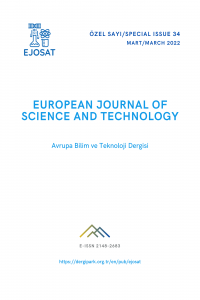Çok Amaçlı Optimizasyon Problemleri için Ayrıştırmaya Dayalı Çok Amaçlı Evrimsel Algoritmada Rastgele Ayrıştırma Yöntemleri
Abstract
Optimizasyon probleminde amaç sayısı arttıkça amaç uzayı da büyümektedir, bu nedenle bu problemlere cevap almak için geleneksel yöntemleri kullanmak mümkün değildir. Bu nedenle, bu sorunu çözmek için bazı yöntemler önerilmektedir. Çözümlerden birine ayrıştırma denir. Ayrıştırmada hedefler skalarizasyon fonksiyonlarına uygulanır ve birçok alt problem elde edilir. Komşuluklarına bağlı olarak, evrimsel algoritmanın mevcut neslindeki en iyi üyeler, bir sonraki nesile aktarılacaktır. Bu fikri kullanan algoritmaya Ayrıştırmaya Dayalı Çok Amaçlı Evrimsel Algoritma (MOEA/D) denir. MOEA/D algoritması ile farklı türde ayrıştırma yöntemleri kullanılabilir. Bununla birlikte, her birinin kendi zayıflıkları veya avantajları vardır. Bu nedenle, ayrıştırma yöntemlerinin dezavantajını azaltmak için bu araştırmada tek bir ayrıştırma yöntemi yerine rastgele iki yöntemin kullanılacağı hibrit bir yaklaşım önerilmiştir. Önerilen hibrit yöntemin performansı, iki metrik kullanılarak yedi test problemi üzerinde gösterilecektir.
References
- Q. Zhang and H. Li “MOEA/D: A Multiobjective Evolutionary Algorithm Based on Decomposition,” IEEE Tran. on Evolutionary Com., vol. 11, no. 6, 2007.
- H. Ishibuchi, Y. Sakane, N. Tsukamoto and Y. Nojima “Adaptation of Scalarizing Functions in MOEA/D: An Adaptive Scalarizing Function-Based Multiobjective Evolutionary Algorithm,” EMO '09: Proceedings of the 5th International Conference on Evolutionary Multi-Criterion Optimization, pp. 438–452, 2009.
- H. Ishibuchi, Y. Sakane, N. Tsukamoto and Y. Nojima “Simultaneous Use of Different Scalarizing Functions in MOEA/D,” GECCO '10: Proceedings of the 12th annual conference on Genetic and evolutionary computation, pp. 519–526, 2010.
- Y. Xia, X. Yang, K. Zhao. “A combined scalarization method for multi-objective optimization problems,” Journal of Industrial & Management Optimization, vol. 17, no. 5, pp. 2669-2683, 2021.
- K. Deb, L. Thiele, M. Laumanns, and E. Zitzler, Scalable Test Problems for Evolutionary Multi-Objective Optimization. Kanpur, India: Kanpur Genetic Algorithms Lab. (KanGAL), India Inst. Technol.,2001. KanGAL Report 2001001.
- K. Miettinen, “Nonlinear Multiobjective Optimization,” Norwell, MA: Kluwer, 1999.
- U. Ozkaya, and L.Seyfi. "A comparative study on parameters of leaf-shaped patch antenna using hybrid artificial intelligence network models." Neural Computing and Applications, 29.8 pp. 35-45, 2018.
- C. Coello D. Veldhuizen and G. Lamont, “Evolutionary Algorithms for Solving Multi-Objective Problems,” Norwell, MA: Kluwer, 2002.
- H. Ishibuchi H. Masuda Y. Tanigaki and Y. Nojima “Modified distance calculation in generational distance and inverted generational distance,” in International Conference on Evolutionary Multi-Criterion Optimization. Springer, 2015, pp. 110–125.
- M. Ehrgott, “Approximation algorithms for combinatorial multicriteria optimization problems,” International Transactions in Operational Research, vol. 7, no. 531, 2000.
Randomized Decomposition Methods in Multi-objective Evolutionary Algorithm based on Decomposition for Many-objective Optimization Problems
Abstract
As the number of objectives are increased in the optimization problem, the objective space is increased therefore it is not possible to use conventional methods to get answers for these problems. Therefore, some methods are proposed to solve this problem. As one of the solutions is called the decomposition. In decomposition the objectives are applied to the scalarization functions, and many sub-problems are obtained. Based on their neighborhood, the best members in the current generation of the evolutionary algorithm will be survived to the next generation. The algorithm which uses that idea is called Multi-objective Evolutionary Algorithm based on Decomposition (MOEA/D). Different typed of decomposition methods can be used with the MOEA/D algorithm. However, each of them has their own weaknesses or advantages. Therefore, to reduce the disadvantage of the decomposition methods, a hybrid approach is proposed in this research such that instead of a single decomposition method, two methods will be use randomly. The performance of the proposed hybrid method will be demonstrated on seven benchmark problems by using two metrics.
References
- Q. Zhang and H. Li “MOEA/D: A Multiobjective Evolutionary Algorithm Based on Decomposition,” IEEE Tran. on Evolutionary Com., vol. 11, no. 6, 2007.
- H. Ishibuchi, Y. Sakane, N. Tsukamoto and Y. Nojima “Adaptation of Scalarizing Functions in MOEA/D: An Adaptive Scalarizing Function-Based Multiobjective Evolutionary Algorithm,” EMO '09: Proceedings of the 5th International Conference on Evolutionary Multi-Criterion Optimization, pp. 438–452, 2009.
- H. Ishibuchi, Y. Sakane, N. Tsukamoto and Y. Nojima “Simultaneous Use of Different Scalarizing Functions in MOEA/D,” GECCO '10: Proceedings of the 12th annual conference on Genetic and evolutionary computation, pp. 519–526, 2010.
- Y. Xia, X. Yang, K. Zhao. “A combined scalarization method for multi-objective optimization problems,” Journal of Industrial & Management Optimization, vol. 17, no. 5, pp. 2669-2683, 2021.
- K. Deb, L. Thiele, M. Laumanns, and E. Zitzler, Scalable Test Problems for Evolutionary Multi-Objective Optimization. Kanpur, India: Kanpur Genetic Algorithms Lab. (KanGAL), India Inst. Technol.,2001. KanGAL Report 2001001.
- K. Miettinen, “Nonlinear Multiobjective Optimization,” Norwell, MA: Kluwer, 1999.
- U. Ozkaya, and L.Seyfi. "A comparative study on parameters of leaf-shaped patch antenna using hybrid artificial intelligence network models." Neural Computing and Applications, 29.8 pp. 35-45, 2018.
- C. Coello D. Veldhuizen and G. Lamont, “Evolutionary Algorithms for Solving Multi-Objective Problems,” Norwell, MA: Kluwer, 2002.
- H. Ishibuchi H. Masuda Y. Tanigaki and Y. Nojima “Modified distance calculation in generational distance and inverted generational distance,” in International Conference on Evolutionary Multi-Criterion Optimization. Springer, 2015, pp. 110–125.
- M. Ehrgott, “Approximation algorithms for combinatorial multicriteria optimization problems,” International Transactions in Operational Research, vol. 7, no. 531, 2000.
Details
| Primary Language | English |
|---|---|
| Subjects | Engineering |
| Journal Section | Articles |
| Authors | |
| Early Pub Date | January 30, 2022 |
| Publication Date | March 31, 2022 |
| Published in Issue | Year 2022 Issue: 34 |


